The largest Chinese cruisers in 1900 – The Hai Tien class were two 4,300 tons armoured cruisers built in Great Britain, at the Armstrong yard, and on a popular model pioneered by the Esmeralda. Steel-hulled, two funnels, two masts with fighting tops, they were ordered in 1895, right after the Sino-Japanese war, ordered and laid down in 1896 and completed in 1899. Their 8 in guns (152 mm) were mounted in turrets fore and aft with electrical mounts, and the 4.7 in guns (102 mm) placed on the broadside amidships. They also featured a complete protected deck in Harvey steel and had a relatively long career. Hai Tien was sunk in 1904 but Hai Chi would be in service in 1937 when the second Sino-Japanese war started. Hai Chi and Hai Tien were the largest ships in the Chinese navy until after World War II.
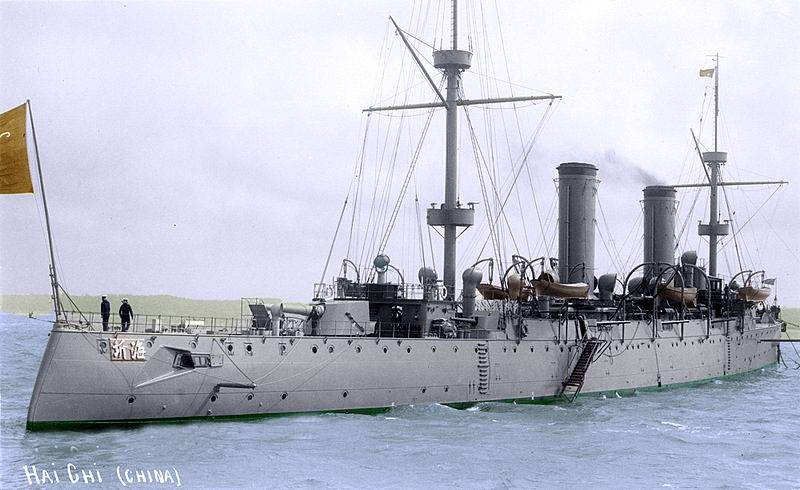
Colorized photo of the Hai chi in 1911 (Library of Congress) by Postales Navales
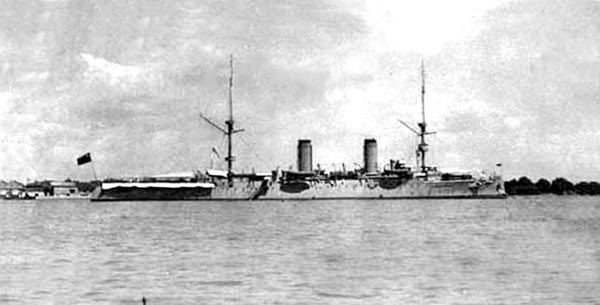
Hai Chi 1935
Context: 1896 Chinese naval plan
With the end of the first Sino-Japanese War in 1895, the Manchu Qing dynasty was left broken. Her proud, costly foreign built fleet of Beiyang had been annihilated in the hands of the Japanese, and her armies decimated on land. The celestial empire’s weakness has been exposed to all, and foreign powers resumed their habits of carving up China with humiliating treaties under the threat of big guns. Among the treaties signed with the Qing government was in 1896 the Li–Lobanov with the Russian Empire, giving out Northeast China. In 1898 this was Convention for Hong Kong with the United Kingdom, a leasing for 99 years. Same lease with the German Empire for Jiaozhou and in 1899, Guangzhouwan to France. But prior to this, the Qing government made a new, ambitious naval plan to be completed by May 1896, all with western-built, modern cruisers.
For this naval plan, a commission was created by the Marquis of Suyi, Li Hongzhang, appointed by the dowager queen. A veteran diplomat of the Qing, he was the honorary guest at the coronation of Nicholas II Romanov, and paraphed and signed the treaty with Aleksey Lobanov-Rostovsky. He was also a guest in Germany, France, Belgium and the UK, arriving in August 1896. In each country, he left competitive requirements for a variety of cruisers and smaller vessels. He later travelled to the United States to try to revoke the Chinese Exclusion Act. Budgetary constraints however tied his hands down, and in the end, the battleship was dropped of the equation, and he could only ask for five cruisers (three from Vulcan, two from Armstrong Whitworth) and four destroyers (Schichau).
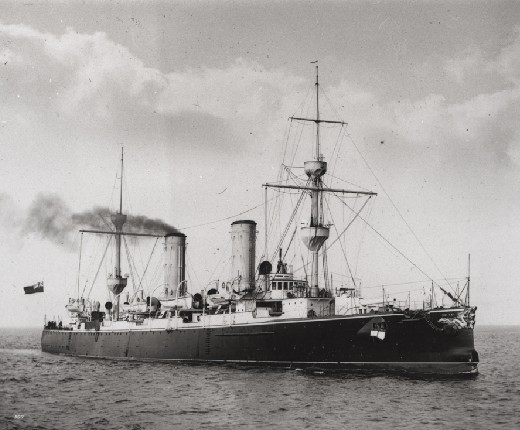
Hai Tien as completed in UK, making her trip to China with a British crew.
The two British-built cruisers were ordered from Armstrong Whitworth. They were named Hai Chi (‘Sea Boundary’) and Hai Tien (‘Heavenly Sea’), ordered in July on plans derived from existing ships and ready in a short notice. Hai Chi was laid down on 11 November 1896. She would be launched on 24 January 1899, commissioned 10 May 1899, so the class was often named after her sister ship, Hai Tien, laid down in February 1897 but launched 25 November 1897 and commissioned earlier, on 28 March 1899.
Hai Chi class design
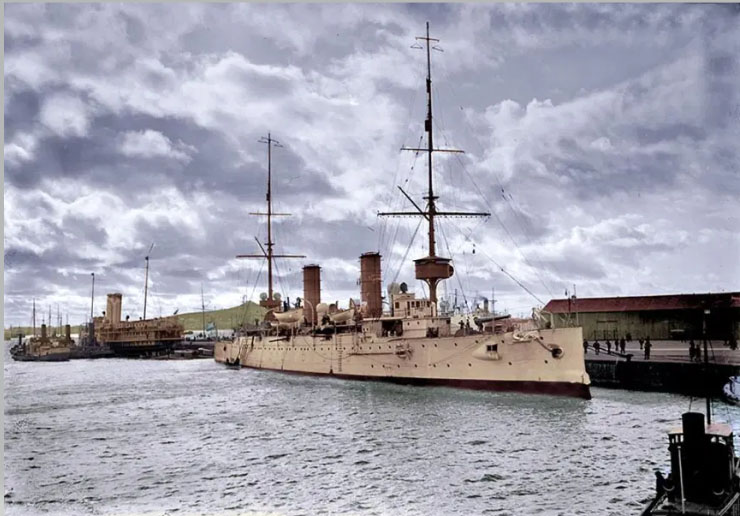
ARA Buenos Aires, the true basis for the design, derived from the Chilean Esmeralda. Colorized photo by Postales Navales
The design for these protected cruisers was closely modelled after the Argentinean ARA Buenos Aires, designed by Philip Watts, the yard’s star naval architect. Armstrong Whitworth had the blueprints in store, and the ship was just one year old. The final cruiser had a displacement of 4,300 tons, up to 4,515 tons fully loaded.
Armour:
The ships’ armour was made from Harvey steel, the latest and world’s best hardening process at that time. The entire protective deck, with sloped sites, when it joined the belt, was 127 mm (5 in) thick on the slopes but down to 37 mm (1 in) mm for the central horizontal section. The Guns were protected by shields 114-millimetre (4.5 in) thick, and their ammunition hoists were 102 mm (4.0 in) thick. The conning tower had walls 152 mm (6.0 in) in thickness. The lightest 3-pdr Hotchkiss mounted in the fighting tops, had also a shield. The bow formed a spur ram and was also reinforced considerably.
Armament:
The armament scheme was directly copied fro the previous Watt’s Buenos Aires: The main battery comprised two single 8 inches guns (exactly 203.2-millimetre) of 45 calibre. They were mounted fore and aft, protected by enveloping and placed on the centreline. However contrary to the previous Argentinian cruiser, there was a coherent, uniform secondary battery of ten secondary guns QF 4.7 inch Mk V naval guns, instead of a mix of 6-inch and 4.7-inch guns. As usual, a tertiary armament was install to deal with torpedo boats, and which comprised sixteen QF 3-pounder Hotchkiss. Latter were placed in part behind superstructure’s walls, broadside, and in the fighting tops (two for the lower, one for upper one). Also as most cruisers of the time, the Hai Chi class was carried five 450 mm (18 in) torpedo tubes. They were all fixed above water, one at the bow, four more broadside, one aft, defending any direction at close range.
Propulsion:
Propulsion was rather classic, but powerful, as the two propellers shafts were driven by four Hawthorn Leslie vertical triple expansion engines. Steam came from twelve cylindrical boilers, with a mix of double-ended and single-ended models, delivering the total output of 17,000 bhp (12,700 kW). Top speed was up to 24.15 knots (27.79 mph; 44.73 km/h) at forced draught. The Hai Tien class carried 1,000 tons of coal, the range established to 8,000 nmi (15,000 km) at 10 knots. Hai Tien’s sea trials showed she could reach normally 22.6 knots (26.0 mph; 41.9 km/h) at natural draught, which was maintained in pursuit.
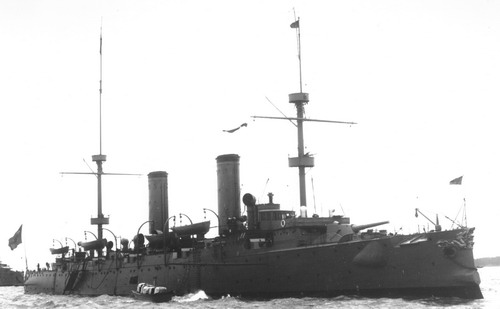
Hai Chi in 1910
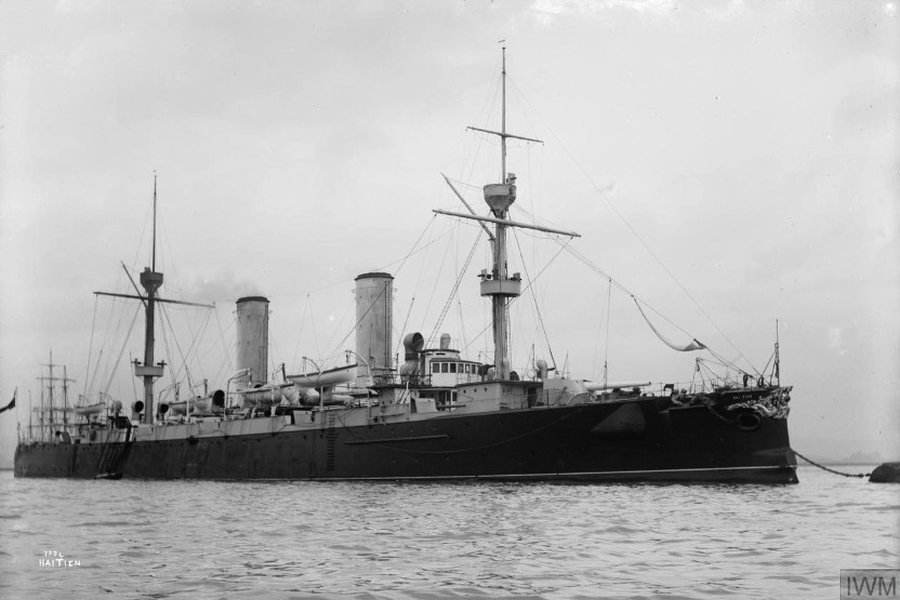
Hai Tien in 1899, as completed
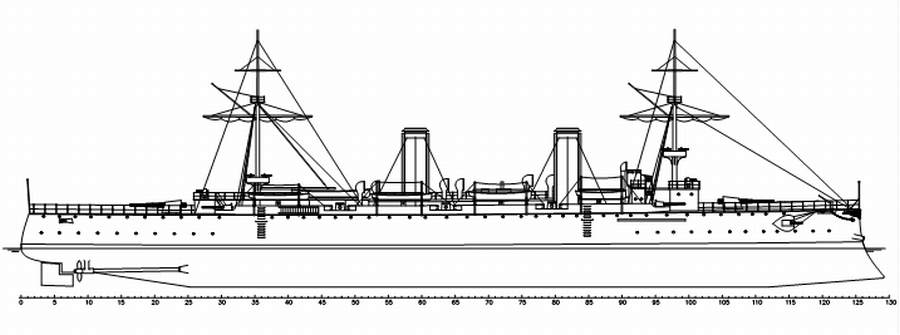
Conway’s profile of the Hai Tien class. Apart the electrical equipment modernization in 1911, Hai Chi appareance changed little, and she receive no meaningful modernization, so that in 1937, she was completely obsolete, when facing the IJN.
Specifications
Specifications* |
|
| Dimensions | 105.5 m x 11.90 m x 4.3 m draft. |
| Displacement | 4,300 tonnes standard -approx. 4,600 tonnes Fully Loaded |
| Crew | 350 |
| Propulsion | 2 shaft VTE, 12 cyl. boilers, 17,000 ihp. |
| Speed | Top speed 24.5 knots, 8000 nm range, about 1000 tons coal. |
| Armament | 2 x 6-in (152 mm), 10 x 5.5 in (140 mm), 16 x 3-in (76 mm), 5 x 18in TTs (457mm) |
| Armor | 40 mm deck with 76 mm belt, 120 mm amo hoists, 130 mm shields, 152 mm CT. |
Src/Read More
Robert Gardiner (Hrsg.): Conway’s All the World’s Fighting Ships 1860–1905
Arlington, L. C., Through the Dragon’s Eyes (London, 1931)
Wright, R. The Chinese Steam Navy, 1862–1945 (London, 2001)
Wright, R. “The Chinese Flagship Hai Chi and the Revolution of 1911”.
On china-defense.blogspot.com
On chroniclingamerica.loc.gov
https://commons.wikimedia.org/wiki/Category:Hai_Chi_class_cruiser
http://www.tynebuiltships.co.uk/H-Ships/haitien1899.html
https://web.archive.org/web/20110109161838/http://www.beiyang.org/bybq/haiyin.htm
http://www.navypedia.org/ships/china/ch_cr_hai_chi.htm
https://ww2db.com/ship_spec.php?ship_id=813
https://en.wikipedia.org/wiki/Beiyang_Fleet
https://www.worldnavalships.com/chinese_navy.htm
http://oceania.pbworks.com/w/page/8450927/Chinese%20Cruisers
https://www.quora.com/Why-did-China-have-no-fleet-after-the-Beiyang-fleet-s-destruction
https://commons.wikimedia.org/wiki/Category:Naval_ships_of_Qing_China
————–
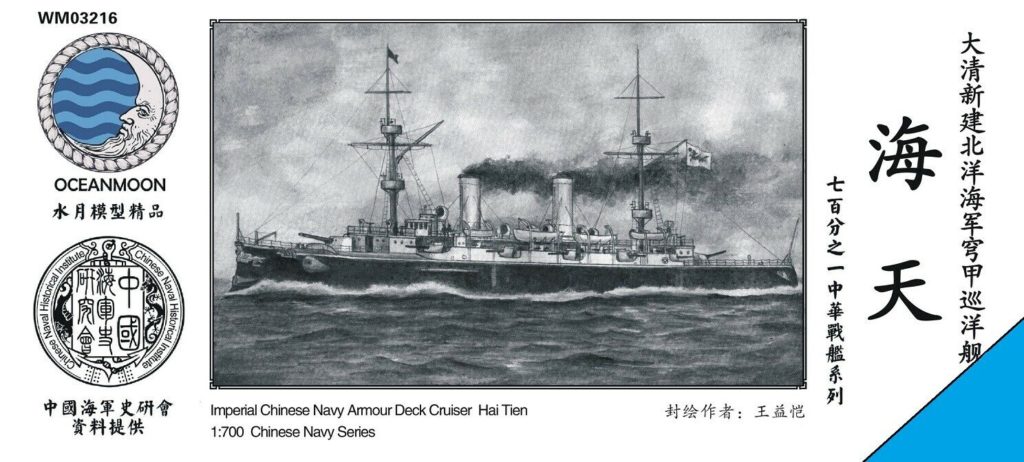
Known Model kit: http://nntmodell.com Oceanmoon 1/700
The Hai Chi in service
Hai Chi was built in 1897-99 by Armstrong Whitworth in Newcastle upon Tyne and sailed for China on 22 May 1899 with a British contract crew. She arrived three weeks later. In August 1899, both cruisers were in China in the the reconstituted Beiyang Fleet, anchored at Dàgū (Taku, famous forts which would led to a battle during the Boxer war). Hai Chi was assigned as flagship, carrying the mark of Commodore Sa Zhenbing, CiC of the Beiyang fleet, the largest and most modern, northern Chinese fleet. The second was the Nanyang fleet, based in Shanghai.
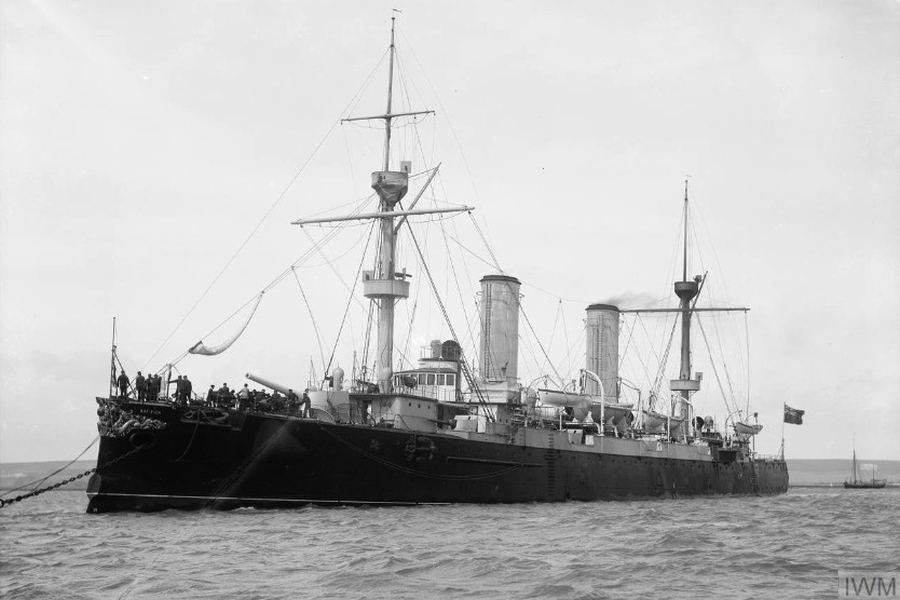
Photos of the Hai Tien in 1899 as completed (Imperial War Museum), on her way to China. typically she had a black hull and canvas bag color and white superstructures. In 1900 or later, 1902-1903, this was changed to overall light grey, as shown by wreck photos of the Hai Tien, unless only her hull was painted white; Most good quality photos of the Hai Chi shows a grey painted vessel.
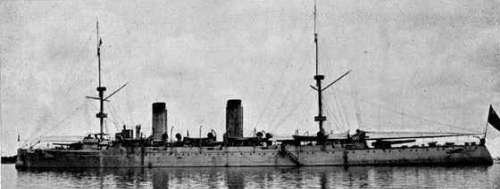
Hai Chi class profile view (Conways)
The Boxer Rebellion
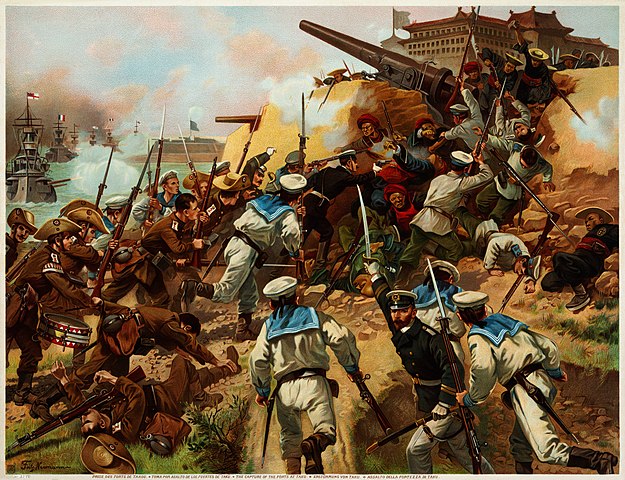
Hai Chi was present during the boxer rebellion, when the Beiyang Fleet sailed for the Taku forts on 31 May 1900. They were to face the alliance fleet, composed of 23 warships from nations implicated in the expedition, with guns facing each others. There was a state of high tension until on 16 June 1900 a delegation was sent by the eight-Nation Alliance fleet. As it was refused, the nations of Russia, UK, Japan, Germany, Austria-Hungary and Italy prepared to bombard the forts and land Marine troops.
The Battle of the Taku Forts: On June 15, electric mines has been deployed in the Peiho River and commanders of the alliance met the following day to decide that Control of the Taku forts was key to control of northern China. Vice-Admiral Hildebrandt (Russian Navy) sent the ultimatum to the commander of the forts, sending it back by telegraph to the Governor of Zhili Province. Terms were to “occupy provisionally, by consent or by force” the Forts. The deadline was 2 a.m. on June 17. USN Rear Admiral Louis Kempff stated he has no authority to undertake hostilities but agreed to send the gunboat USS Monocacy to take on civilians near the fort out of harm. Only ten ships crossed over the river banks and entered the Hai River 200 yds wide and 900 men were assembled while the Chinese gunners, troops and sailors of gunboats had 2,000 men. In addition of mines torpedo tubes were installed at the forts. The first shots were Chinese, at about 00:45 on June 17. Korietz was heavily damage and Monocacy took a hit and was moved away. HMS Whiting, SMS Iltis, Lion and Giliak were also all hit, and severely damaged. Four modern German-built destroyers alongside the dock at Taku were swiftly captured by men from HMS Whiting and HMS Fame. The artillery duel went on until dawn until the ground assault took place on the Northwest Fort, with 200 Russians and Austrians followed by 380 British and Italians and next 300 Japanese. Fortunately a lucky hit blasted the fort’s powder magazine, opening a breech and causing a massive confusion, helping the the Japanese storming the fort, while the British and Italians assaulted North Fort. Next the fleet bombarded the forts on the south side of the river. Another powder magazine blew up in one, and they were abandoned, captured later with almost no opposition. All this was over at 6:30 a.m.
Hai Chi is evacuated
The remainder of the Beiyang fleet was evacuated southwards. Hai Chi was anchored in Jiangyin, spending the year 1901 with the the Nanyang Fleet until peace was signed. In 1904 both ships were stationed at Zhifu harbor. Her sister ship was moving to Shanghai when she struck a reef and was stuck there and eventually lost, abandoned, leaving Hai Chi the sole ship of her class. The next years were uneventful for Hai Chi, due to limited budget for training. She spent these years mostly at anchor.
Revolution
In 1911, Hai Chi visited the United Kingdom, representing China at the grand fleet review in honor to George V’s coronation, in Spithead. The British-built cruiser profited from it to make a stop at Newcastle and be equipped with a completely new electrical network and generators, at Armstrong Whitworth. She received a message about the Torreón massacre in Mexico, and soon sailed to visit the United States, Cuba and Mexico, possibly taking on nationals. On 11 September 1911, she became in effect the first Imperial Chinese warship to enter American waters. She soon sailed to Cuba and then Mexico. The country, under the gun’s threat, agreed to Chinese demands for reparations and took action against the rebels. Hai Chi then sailed home, mission accomplished, only to discover the Empire has fallen and that a new government was in place. This was the Republic of China.
Hai Chi therefore changed flag, swapping the old dragon on yellow background of the Empire to the red-blue and sun symbol of the Republic. However, the situation was agitated, civil war was near. In 1917, the cruiser joined the fleet loyal to Sun Yat-sen’s Constitutional Protection Movement. War erupted against the secessionist Beijing government. In 1923, Hai Chi returned in the north, and in 1926 joined the Fengtian clique, headed by Gen. Zhang Zuolin in Manchuria. Manchuria was lost to Japan after the Mukden Incident in 1931, and Hai Chi sailed to Qingdao with other Fengtian ships and carrying troops. Soon after was constituted the ROC Navy’s 3rd Fleet. In 1933 due to the fleet commander fauling to pay the crews, Hai Chi sailed with two other ships south and, to the Guangdong navy. In 1935, the governor of Guangdong province disgruntled the crews, and Hai Chi, and another cruiser, fought heir way through a blockade and reach Hong Kong, and from there, sailed to Nanjing. There, after negociations, a compromise was found, and the ships were now nominally part of the Third Fleet, but under direct command of the ministry of defence.
As the sino-Japanese war erupted two years later, Hai Chi, which by that time has been little modernized, was scuttled as a blockship in the Yangtze River. This decision was taken on 11 August 1937, to obstruct the Japanese advance. It was motivated by simple common sense, as she would have stood little chance against modern Japanese cruisers and battleships, or the aviation. Without any significant modernization she was toothless indeed. However her main guns were still valuable enough to be dismantled before scuttling. Her heavy and secondary guns were later installed in the riverine defences of Wuhan. So the cruiser never had the occasion to fight the Japanese.
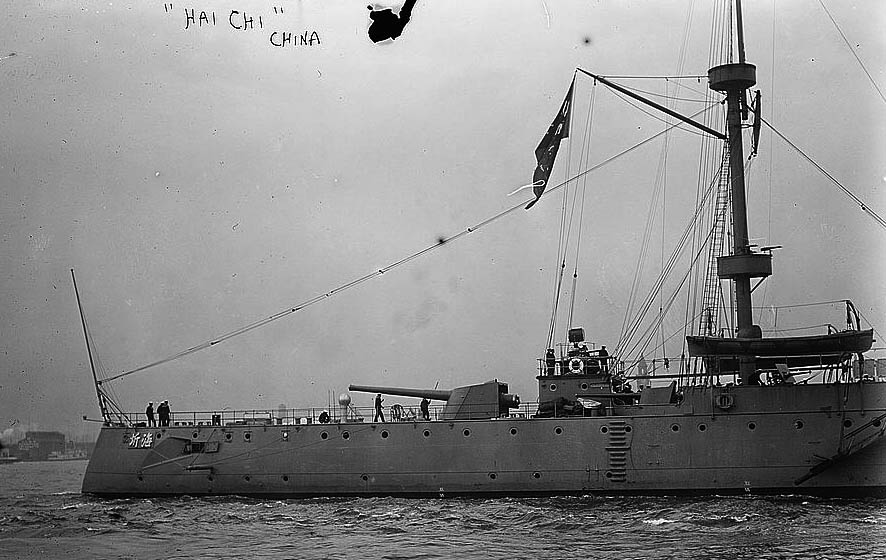
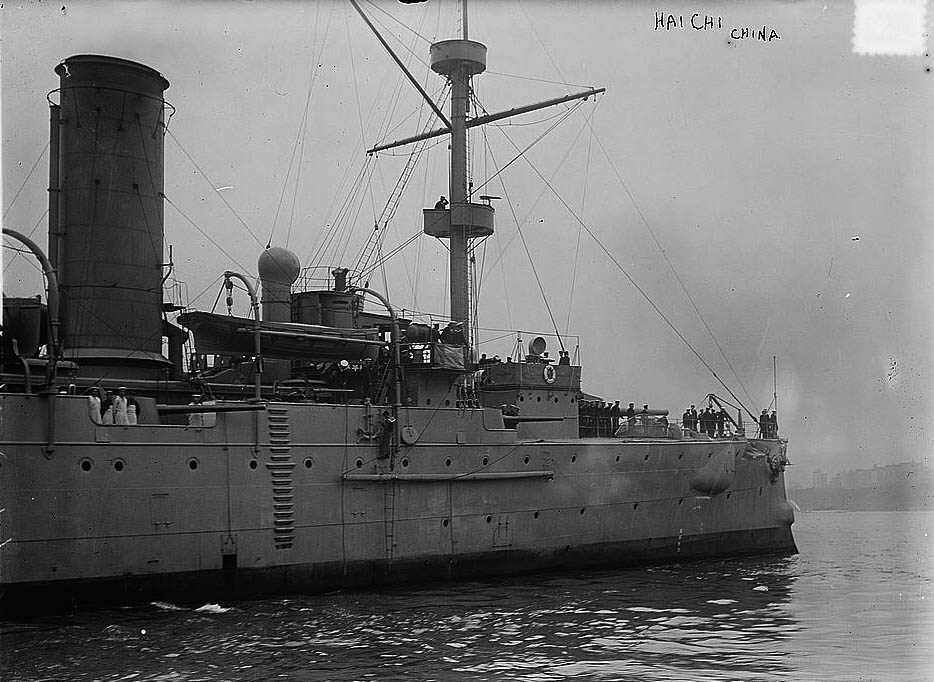
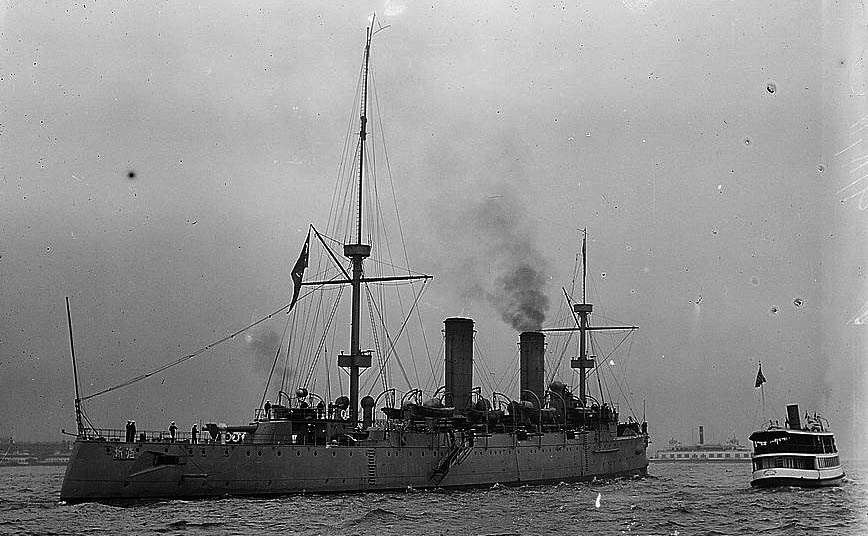
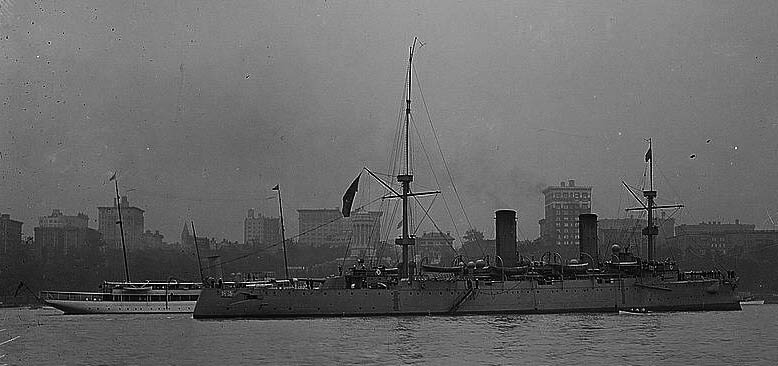
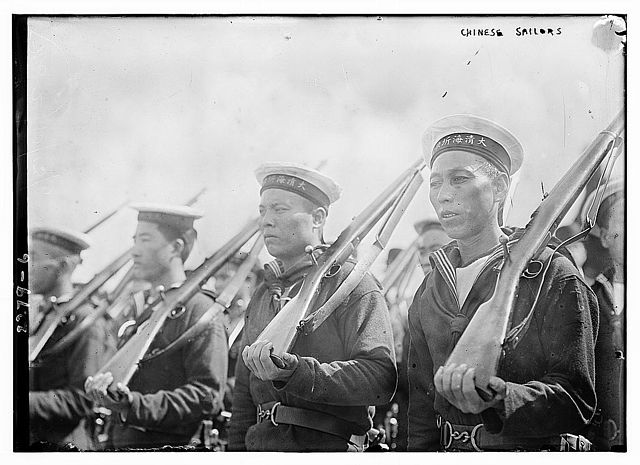
Various photos of the Hai Chi and sailors in 1911, now part of the American Congress collection, open source.
The Hai Tien in service
Hai Tien, although laid down 16 February 1897, three months after Hai Chi, launched 25 November 1897, before Hai Chi, was also completed a month ahead, but despite of this many historians still consider this the Hai Chi class. She was handed over to reconstitute China’s Beiyang Fleet by August 1899.
Hai Tien had a brief and uneventful career for Qing, as soon after the start of Boxer Rebellion, as chaos predominated, the Beiyang Fleet sailed to reinforce the Dagu forts on 31 May 1900. There was an uneasy state of high alert as a massive foreign fleet of 23 warships assembled in the area, facing the Chinese fleet. Tensions went a step further but still no ship ever fired a shot, until the deadlock was broken on 16 June 1900: The Eight-Nation Alliance fleet moved for a decisive outcome, anchoring off Dagu and making an ultimatum to the forts, intimating them to surrender or face a heavy shelling. This was in order to relieve International Legations siege in Beijing, the famous “55 days”.
The commanding officer of the forts was named General Luo Rongguang. He refused, and ordered to open fire on the foreign ships, leading to the Battle of Dagu Forts. At the same time, the more prudent governor of Shandong, Yuan Shikai, thought the Boxer rebellion was pointless. He ordered the Beiyang fleet south to preserve her in case of a sea battle where its stood little chance, and tp prevent these ships to be captured. Indeed he remembered what happened to the four newly acquired, German-built Hai Long-class destroyers and torpedo gunboat Fei Ting, captured by alliance during the capture of the docks near the Forts of Dagu (Taku). Off Taku forts, the Beiyang fleet was now limited to the cruisers Hai Tien, Hai Chou, Hai Chen, and the torpedo gunboat Hai Ying. They sailed to Shanghai, and Jiangyin, where they anchored to spend 1901 with the the Nanyang Fleet, until the end of the war, which was signed on 7 September 1901. There, the entire combined Chinese fleet was preserved for better days, which appeared as a wise decision.
Four years later, at 5:30 AM, 25 April 1904, the cruiser Hai Tien sailed under command Liu Guanxiong (future admiral of the Qin fleet), heading for Shanghai, from Zhifu harbour. She crossed hevy fog off Weihai, overshot the entrance to the Yangtze River, and hit a pinnacle rock close to the Shengsi Islands (Hangzhou Bay). The cruiser’s crew could do little as the ship was stuck in such position ot would take a lot to tow her. The captain ordered to abandon her in the evening. The crew was rescued by Chinese customs cruisers. Subsequently, attempts were made to salvage the Ha Tien. But they all failed. Ultimately it was decided to save her 8 inch 45 caliber main guns. She was struck from the Chinese naval register and her hull was left there to rust and being battered by the elements. Its last remains are still buried under the sands of the area.
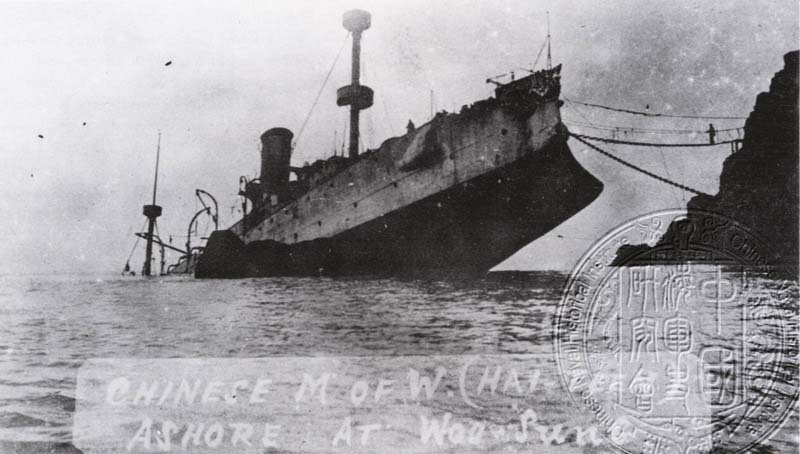
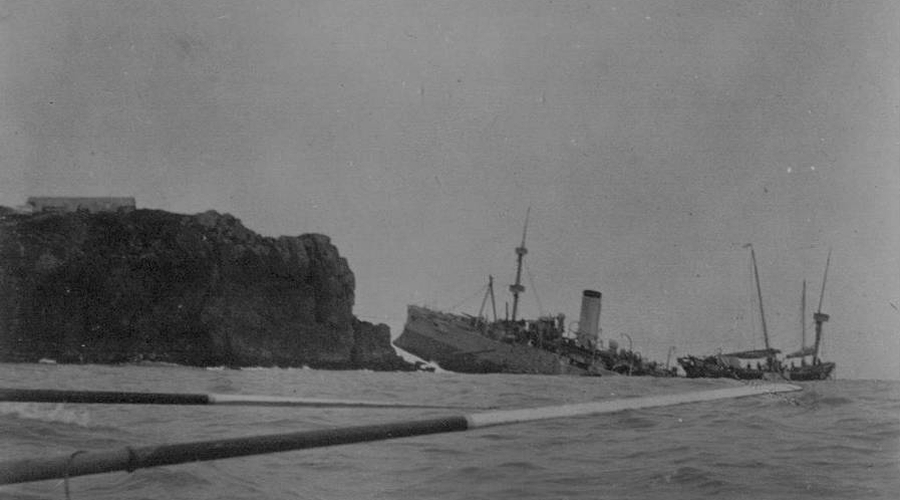
Two photos of the wreck of Hai Tien in 1904 (cc).



 Latest Facebook Entry -
Latest Facebook Entry -  X(Tweeter) Naval Encyclopedia's deck archive
X(Tweeter) Naval Encyclopedia's deck archive Instagram (@navalencyc)
Instagram (@navalencyc)





 French Navy
French Navy Royal Navy
Royal Navy Russian Navy
Russian Navy Armada Espanola
Armada Espanola Austrian Navy
Austrian Navy K.u.K. Kriegsmarine
K.u.K. Kriegsmarine Dansk Marine
Dansk Marine Nautiko Hellenon
Nautiko Hellenon Koninklije Marine 1870
Koninklije Marine 1870 Marinha do Brasil
Marinha do Brasil Osmanlı Donanması
Osmanlı Donanması Marina Do Peru
Marina Do Peru Marinha do Portugal
Marinha do Portugal Regia Marina 1870
Regia Marina 1870 Nihhon Kaigun 1870
Nihhon Kaigun 1870 Preußische Marine 1870
Preußische Marine 1870 Russkiy Flot 1870
Russkiy Flot 1870 Svenska marinen
Svenska marinen Søværnet
Søværnet Union Navy
Union Navy Confederate Navy
Confederate Navy Armada de Argentina
Armada de Argentina Imperial Chinese Navy
Imperial Chinese Navy Marinha do Portugal
Marinha do Portugal Mexico
Mexico Kaiserliche Marine
Kaiserliche Marine 1898 US Navy
1898 US Navy Sovietskiy Flot
Sovietskiy Flot Royal Canadian Navy
Royal Canadian Navy Royal Australian Navy
Royal Australian Navy RNZN Fleet
RNZN Fleet Chinese Navy 1937
Chinese Navy 1937 Kriegsmarine
Kriegsmarine Chilean Navy
Chilean Navy Danish Navy
Danish Navy Finnish Navy
Finnish Navy Hellenic Navy
Hellenic Navy Polish Navy
Polish Navy Romanian Navy
Romanian Navy Turkish Navy
Turkish Navy Royal Yugoslav Navy
Royal Yugoslav Navy Royal Thai Navy
Royal Thai Navy Minor Navies
Minor Navies Albania
Albania Austria
Austria Belgium
Belgium Columbia
Columbia Costa Rica
Costa Rica Cuba
Cuba Czechoslovakia
Czechoslovakia Dominican Republic
Dominican Republic Haiti
Haiti Hungary
Hungary Honduras
Honduras Estonia
Estonia Iceland
Iceland Eire
Eire Equador
Equador Iran
Iran Iraq
Iraq Latvia
Latvia Liberia
Liberia Lithuania
Lithuania Mandchukuo
Mandchukuo Morocco
Morocco Nicaragua
Nicaragua Persia
Persia San Salvador
San Salvador Sarawak
Sarawak Uruguay
Uruguay Venezuela
Venezuela Zanzibar
Zanzibar Warsaw Pact Navies
Warsaw Pact Navies Bulgaria
Bulgaria Hungary
Hungary

 Bundesmarine
Bundesmarine Dutch Navy
Dutch Navy Hellenic Navy
Hellenic Navy Marina Militare
Marina Militare Yugoslav Navy
Yugoslav Navy Chinese Navy
Chinese Navy Indian Navy
Indian Navy Indonesian Navy
Indonesian Navy JMSDF
JMSDF North Korean Navy
North Korean Navy Pakistani Navy
Pakistani Navy Philippines Navy
Philippines Navy ROKN
ROKN Rep. of Singapore Navy
Rep. of Singapore Navy Taiwanese Navy
Taiwanese Navy IDF Navy
IDF Navy Saudi Navy
Saudi Navy Royal New Zealand Navy
Royal New Zealand Navy Egyptian Navy
Egyptian Navy South African Navy
South African Navy






























 Ukrainian Navy
Ukrainian Navy dbodesign
dbodesign
Colorized photos by PostalesNavales
https://www.facebook.com/pg/Postales-Navales-100381150365520/posts/?ref=page_internal
https://www.facebook.com/pg/Postales-Navales-100381150365520/posts/?ref=page_internal